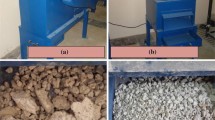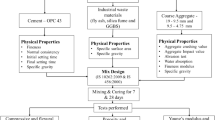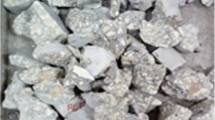Abstract
The paper presents the results of an investigation conducted to study the strength properties of pervious concrete containing coarse recycled concrete aggregates (RCA). In this study, 13 pervious concrete mixes were prepared with the use of RCA replacing coarse natural aggregates (NA) by 0, 25, 50, 75 and 100%. Keeping the water–cement (w/c) ratio constant, Viscosity Modified Agent (VMA) was added at 0.8% by weight of binder content. Being environmentally advantageous, 30% Fly Ash (FA) has been added with 70% Ordinary Portland Cement (PC) in the binder of control mix. Despite being environmentally safe product, metakaolin (MK) also tends to enhance the properties of concrete containing RCA. Therefore, keeping the PC content 70% for all mixes, FA was replaced with MK at two different levels of 5% and 10% to improve the properties of pervious concrete made with RCA. Specimens in the form of cubes, cylinders and beams were prepared for studying the mechanical properties at different ages of curing. The test results showed that there was significant loss in compressive, splitting tensile and flexural strength of pervious concrete while increasing the percentage of RCA replacing NA. Addition of 5% MK compensated the decrement noticed in the strength properties after replacement of NA with RCA. The mix with 25% RCA and 5% MK was having almost same compressive strength as that of reference mix. 10% MK further enhanced the strength properties and it was concluded that loss of compressive strength in pervious concrete due to addition of 50% RCA can be compensated by the addition of 10% MK.










Similar content being viewed by others
References
Aliabdo AA, Elmoaty AE, Fawzy AM (2018) Experimental investigation on permeability indices and strength of modified pervious concrete with recycled concrete aggregate. Constr Build Mater 193:105–127
ACI 522 Committee Report (2010) Report on pervious concrete. American Concrete Institute, Farmington Hills
Arora S, Singh SP (2019) Probability of failure of RCA concrete with ternary blended cements. Constr Build Mater 225:401–414
American Society for Testing and Materials (ASTM) C618 (2019) Standard specification for coal fly ash and raw or calcined natural pozzolan for use in concrete. ASTM, West Conshohocken
American Society for Testing and Materials (ASTM) D2434 (2019) Standard test method for permeability of granular soils (constant head). ASTM, West Conshohocken
Barnhouse PW, Srubar WV III (2016) Material characterization and hydraulic conductivity modelling of macroporous recycled–aggregate pervious concrete. Constr Build Mater 110:89–97
Beeldens A (2002) Influence of polymer modification on the behavior of concrete under severe conditions. Ph.D. Dissertation, Faculty of Engineering, Katholieke Universiteit, Leuven, pp 248
Beeldens A, Van Gemert D, Caestecker C, Van Messem M (1998) Mechanical properties and structure of porous concrete. In: Proceedings of the 8th international symposium on concrete roads, Lisbon, pp 129–134
Bhutta MAR, Tsuruta K, Mirza J (2012) Evaluation of high performance porous concrete properties. Constr Build Mater 31:67–73
Brake NA, Allahdadi H, Adam F (2016) Flexural strength and fracture size effects of pervious concrete. Constr Build Mater 113:536–543
Chandrappa AK, Biligiri KP (2016) Pervious concrete as a sustainable pavement material—research findings and future prospects: a state-of-the-art review. Constr Build Mater 111:262–274
Chen Y, Wang K, Wang X, Zhou W (2013) Strength, fracture and fatigue of pervious concrete. Constr Build Mater 42:97–104
Chen Y, Zhang Q (2009) Manufacturing technology of porous cement concrete highway construction. Geotech Spec Publ Road Pavement Mater Charact Rehabil Am Soc Civil Eng 191:22–33
Cosic K, Korat L, Ducman V, Netinger I (2015) Influence of aggregate type and size on properties of pervious concrete. Constr Build Mater 78:69–76
Delatte N, Mrkajic A, Miller DI (2009) Field and laboratory evaluation of pervious concrete pavements. Transp Res Rec J Transp Res Board. https://doi.org/10.3141/2113-16
Gaedicke C, Torres A, Hynh Khanh CT, Marines A (2017) A method to correlate splitting tensile strength and compressive strength of pervious concrete cylinders and cores. Constr Build Mater 125:271–278
Ghafoori N, Dutta S (1995) Laboratory investigation of compacted no–fines concrete for paving materials. J Mater Civ Eng 7(3):183–191
Guneyisi E, Gesoglu M, Kareem Q, Ipek S (2014) Effect of different substitution of natural aggregate by recycled aggregate on performance characteristics of pervious concrete. Mater Struct. https://doi.org/10.1617/s11527-014-0517-y
Indian Standard, IS:5816-1999 (1999) Method of test splitting tensile strength of concrete. Bureau of Indian Standards, New Delhi
Indian Standard, IS:13311-(Part 1)-1992 (1992) Non-destructive testing of concrete—methods of test (ultrasonic pulse velocity). Bureau of Indian Standards, New Delhi
Indian Standard, IS:516-1959 (1959) Methods of test for strength of concrete. Bureau of Indian Standards, New Delhi
Indian Standard, IS:1199-1959 (1959) Methods of sampling and analysis of concrete. Bureau of Indian Standards, New Delhi
Ibrahim A, Mahmoud E, Tamin M, Patibandla VC (2014) Experimental study on Portland cement pervious concrete mechanical and hydrological properties. Constr Build Mater 50:524–529
ISO 2005 (2005) Business plan. ISO/TC 71 concrete, reinforced concrete and prestressed concrete. Geneva
Kajio S, Tanaka S, Tomita R, Noda E, Hashimoto S (1998) Properties of porous concrete with high strength. In: Proceedings of the 8th international symposium on concrete roads, Lisbon, pp 171–177
Kapoor K, Singh SP, Singh B (2016) Durability of self-compacting concrete made with recycled concrete aggregates and mineral admixtures. Constr Build Mater 128:67–76
Khankhaje E, Rafieizonooz M, Salim MR, Khan R, Mirja J, Siong HC, Salmiati (2018) Sustainable clean pervious concrete pavement production incorporating palm oil fuel ash as cement replacement. J Clean Prod 172:1476–1485
Limbachiya MC, Leelawat T, Dhir RK (2000) Use of recycled concrete aggregate in high–strength concrete. Mater Struct 33:574–580
López-Carrasquillo V, Hwang S (2017) Cooperative assessment of pervious concrete mixtures containing fly ash and nanomaterials for compressive strength, physical durability, permeability, water quality performance and production cost. Constr Build Mater 139:148–158
Marolf A, Neithalath N, Sell E, Wegner K, Weiss J, Olek J (2004) Influence of aggregate size and gradation on acoustic absorption of enhanced porosity concrete. ACI Mater J 101(1):82–91
Johari MAM, Brooks JJ, Kabir S, Rivard P (2011) Influence of supplementary cementitious materials on engineering properties of high strength concrete. Constr Build Mater 25:2639–2648
Monters F (2006) Pervious concrete: characterization of fundamental properties and simulation of microstructure. Ph.D. Dissertation, University of South Carolina
Muduli R, Mukharjee BB (2018) Effect of incorporation of metakaolin and recycled coarse aggregate on properties of concrete. J Clean Prod. https://doi.org/10.1016/j.jclepro.2018.10.221
Öznur Öz H (2018) Properties of pervious concretes partially incorporating acidic pumice as coarse aggregate. Constr Build Mater 166:601–609
Park SB, Seo DS, Lee J (2005) Studies on the sound absorption characteristics of porous concrete based on the content of recycled aggregate and target void ratio. Cem Concr Res 35(9):1846–1854
Rahal K (2007) Mechanical properties of concrete with recycled coarse aggregate. Build Environ 42:407–415
Sata V, Wongsa A, Chindaprasirt P (2013) Properties of pervious geopolymer concrete using recycled aggregates. Constr Build Mater 42:33–39
Semadeni-Davies A, Hernebring C, Svensson G, Gustafsson L-G (2008) The impacts of climate change and urbanization on drainage in Helsingborg, Sweden: Suburban stormwater. Hydrology 350:114–125
Siddique R, Khan MI (2011) Supplementary cementing materials, engineering materials, ISBN 978-3-642-17865-8. https://doi.org/10.1007/978-3-642-17866-5
Singh N, Singh SP (2016) Carbonation and electrical resistance of self compacting concrete made with recycled concrete aggregates and metakaolin. Constr Build Mater 121:400–409
Singh N, Mithulraj M, Arya S (2019) Utilization of coal bottom ash in recycled concrete aggregates based self compacting concrete blended with metakaolin. Resour Conserv Recycl 144:240–251
Tamai M, Mizuguchi H, Hatanaka S, Katahira H, Nakazawa T, Yanagibashi K, Kunieda M (2004) Design, construction and recent applications of porous concrete in Japan. In: Proceedings of the JCI symposium on design, construction and recent applications of porous concrete. Japan Concrete Institute, Tokyo, pp 1–10
Tennis PD, Leming ML, Akers DJ (2004) Pervious concrete pavements. Portland Cement Association Skokie Illinois, Silver Spring, p 14
Thakali R, Kalra A, Ahmad S (2016) Understanding the effects of climate change on urban stormwater infrastructures in the Las Vegas Valley. Hydrology 2016(3):34
Vejmelkova E, Pavlikova M, Keppert M, Kersner Z, Rovnanikova P, Ondracek M et al (2010) High performance concrete with Czech metakaolin: experimental analysis of strength, toughness and durability characteristics. Constr Build Mater 24:1404–1411
Wang W (1997) Study of pervious concrete strength. Sci Technol Build Mater China 6(3):25–28
Yang J, Jiang G (2003) Experimental study on properties of pervious concrete pavement materials. Cem Concr Res 33:381–386
Yang KH, Chung HS, Ashour AF (2008) Influence of type and replacement level of recycled aggregates on concrete properties. ACI Mater J 105(3):289–296
Zaetang Y, Sta V, Wongsa A, Chindaprasirt P (2016) Properties of pervious concrete containing recycled concrete block aggregate and recycled concrete aggregate. Constr Build Mater 111:15–21
Zhang Z, Zhang Y, Changgen Y, Liu Y (2017) Influence of crushing index on properties of recycled aggregates pervious concrete. Constr Build Mater 135:112–118
Zhou J, Zheng M, Wang Q, Yang J, Lin T (2016) Flexural fatigue behavior of polymer-modified pervious concrete with single sized aggregates. Constr Build Mater 124:897–905
Acknowledgements
The authors of the present study are grateful for the cooperation of the technical staff of Concrete Laboratory of the institution, throughout the whole experimental process described in this paper. The first author also acknowledges the support provided by Sika India Pvt. Ltd.
Author information
Authors and Affiliations
Corresponding author
Ethics declarations
Conflict of interest
On behalf of all authors, the corresponding author states that there is no conflict of interest.
Rights and permissions
About this article
Cite this article
Singh, D., Singh, S.P. Influence of recycled concrete aggregates and blended cements on the mechanical properties of pervious concrete. Innov. Infrastruct. Solut. 5, 66 (2020). https://doi.org/10.1007/s41062-020-00314-x
Received:
Accepted:
Published:
DOI: https://doi.org/10.1007/s41062-020-00314-x




